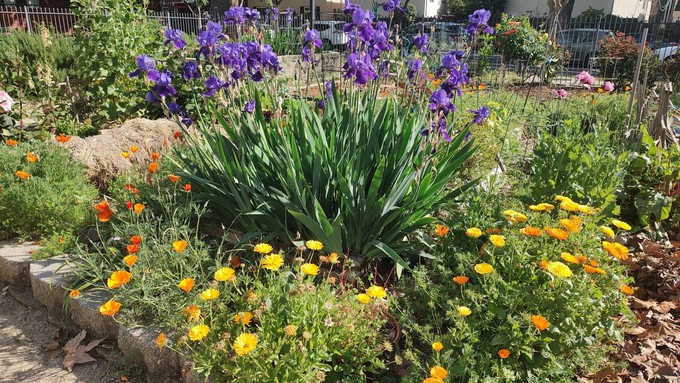
Green Acres' irrigation experts show how to put right plants in the right place for water-wise success

Hydrozoning groups together plants with similar water needs. These combinations also can look as pretty as they are water efficient such as this grouping of bearded irises, calendulas and poppies. Debbie Arrington
How much water does my garden really need? It depends on several factors – including which plants are where.
Putting plants together that share similar needs – including irrigation requirements – is the underlying principle of “hydrozoning.” Learn how during free workshops offered at 10 a.m. Saturday, June 8, at all seven locations of Green Acres Nursery & Supply.
“Irrigation: Hydrozoning Basics” will be June’s “Garden Talk” workshop topic during Green Acres’ series. Garden gurus at each nursery will explain how hyrdrozoning works including examples of plant combinations and suggested irrigation times and amounts. During the one-hour seminar, they’ll also answer questions about irrigation and conversion to a low-water landscape.
No advance registration is necessary. Admission and parking are free.
Also on Saturday, Green Acres will offer a demonstration and tasting of the Big Green Egg charcoal grill, only at its Roseville location. Find out what makes the Big Green Egg so effective and taste some results from 10 a.m. to 2 p.m.
Green Acres’ Roseville nursery is located at 7300 Galilee Road. Other Green Acres nurseries participating in Saturday’s hydrozoning workshops are in Sacramento, Auburn, Citrus Heights, Elk Grove, Folsom and Rocklin.
For addresses, directions and more details: https://idiggreenacres.com/.
Comments
0 comments have been posted.Sacramento Digs Gardening to your inbox.
Food in My Back Yard Series
April 29: What's (already) wrong with my tomato plants?
April 22: Should you stock up on fertilizer? (Yes!)
April 15: Grow culinary herbs in containers
April 8: When to plant summer vegetables
April 1: Don't be fooled by these garden myths
March 25: Fertilizer tips: How to 'feed' your vegetables for healthy growth
March 18: Time to give vegetable seedlings some more space
March 11: Ways to win the fight against weeds
March 4: Potatoes from the garden
Feb. 25: Plant a fruit tree now -- for later
Feb. 18: How to squeeze more food into less space
Feb. 11: When to plant? Consider staggering your transplants
Feb. 4: Starting in seed starting
Sites We Like
Garden Checklist for week of May 4
Enjoy this spring weather – and get gardening!
* Plant, plant, plant! It’s prime planting season in the Sacramento area. Time to set out those tomato transplants along with peppers and eggplants. Pinch off any flowers on new transplants to make them concentrate on establishing roots instead of setting premature fruit.
* Direct-seed melons, cucumbers, summer squash, corn, radishes, pumpkins and annual herbs such as basil.
* Harvest cabbage, lettuce, peas and green onions.
* In the flower garden, direct-seed sunflowers, cosmos, salvia, zinnias, marigolds, celosia and asters. (You also can transplant seedlings for many of the same flowers.)
* Plant dahlia tubers. Other perennials to set out include verbena, coreopsis, coneflower and astilbe.
* Transplant petunias, marigolds and perennial flowers such as astilbe, columbine, coneflowers, coreopsis, dahlias, rudbeckia and verbena.
* Keep an eye out for slugs, snails, earwigs and aphids that want to dine on tender new growth.
* Feed summer bloomers with a balanced fertilizer.
* For continued bloom, cut off spent flowers on roses as well as other flowering plants.
* Add mulch to the garden to maintain moisture. Mulch also cuts down on weeds. But don’t let it mound around the stems or trunks of trees or shrubs. Leave about a 6-inch to 1-foot circle to avoid crown rot or other problems.